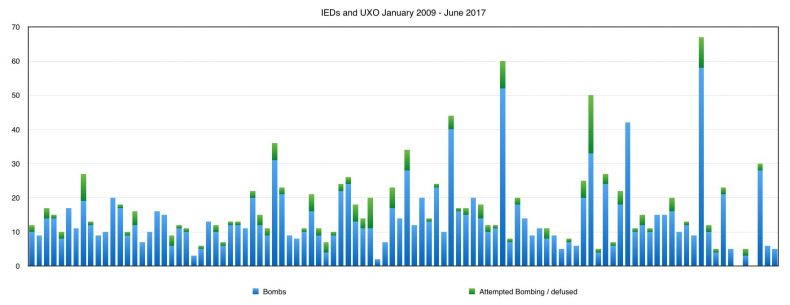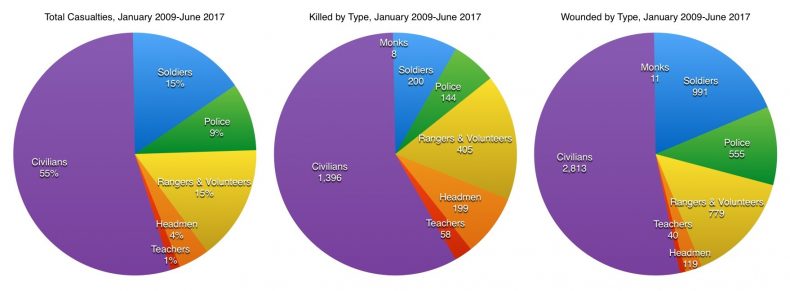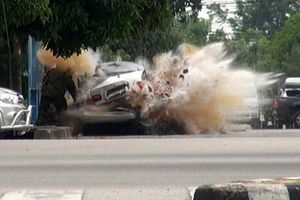In the embers of the May 9 double bombing at a big-box store in downtown Pattani, the Royal Thai Army (RTA) claimed that violence in the restive south had declined by 33 percent over the past 6 months. Yet the insurgency, now in its 14th year, shows no end in sight. A 19 June IED killing six soldiers and wounding four more, or a June 23 bomb that wounded 12 soldiers and two civilians, or a July 15 assault on a restaurant that wounded seven Buddhists — these should set off alarm bells in Bangkok. But in fact, the insurgency, which has claimed the lives of nearly 7,000, remains a low priority for the junta.
Trends in Violence
Violence in the Deep South has dropped from its 2007 peak, when 836 people were killed. In 2016, that number was 307, well below the 14 year average of 455.

But when one looks at the overall casualty rate, based on my very conservative open source data set, the numbers remain high. Indeed, since the coup in 2014, when one should anticipate no checks on military operations or civilian oversight, there is discernible monthly variation. The tempo of the insurgency is driven by resources and logistics, not RTA operations.

The data on improvised explosive devices (IEDs) shows a clear pattern: insurgents build up their stores, execute attacks, and then have to go through the gradual process of replenishing their stocks. It is not government counter-insurgency operations that impede the insurgents, but their own logistical limitations.
Since 2009, there have been an average of 15.4 IEDs a month. In 2016, the average number rose to 17.1. While the government takes credit for a overall decline in violence, successful IED attacks have actually risen since 2009. There is one change: Bombings in urban areas, such as the May 9 bombings at the Big C, are now the exception; most IEDs target security forces in rural areas.

While the minority of casualties of bombings are civilians, the same cannot be said for shootings. The targets are intentional: Buddhist civilians, headmen that defy insurgent demands, village defense volunteers, or Muslim civilians who defy the insurgents or are deemed informers. On June 21, militants gunned down a prominent Islamic teacher who served as an adviser to the Internal Security Operations Command as he left prayers with his family. Since 2013, there have been an average of 13.3 shootings a month.
40 percent of total casualties are security forces, though they comprise only 31 percent of the dead. But 60 percent remain civilians, and at least 87 children have been killed and 554 wounded since 2004.

Since 2014, the government has stepped up checkpoints across the south that have made operations more risky for insurgents; they can no longer attack at will. But the level of violence is largely dictated by the insurgents, often in the form of retaliatory attacks in response to government actions. Through feedback loops in their community, insurgents have calibrated the degree of violence necessary to achieve their short-term goals of weakening governance, provoking heavy-handed security force responses, driving Buddhists out of the south, and undermining government pledges of desiring peace and reconciliation. Too much violence is counter-productive.
Violence has plateaued since 2009. There are monthly rhythms that are as often dictated by the weather or flooding as anything else. There are months when violence is low, which the army takes credit for, only to become complacent and see a spike the following month.
That is until this year, when violence has fallen sharply. By the end of June 2017, only 50 people had been killed and 138 wounded. Almost half of the wounded were from one incident, alone. That is an average of only 8.3 and 23 people a month killed and wounded, respectively. In 2016 those numbers were 12.8 and 35.2, respectively. The first half of 2017 saw only 42 successful IED attacks, an average of 7.4, and 28 shootings. Arson, attacks on security force outposts, and firefights are all down.
So what explains this drop in the violence? Evidence points to two factors: the peace process, and leadership changes within the Barisan Revolusi National (BRN).
Following the May 2016 death of Masae Using and January 2017 death of Sapaeing Basoe, the BRN has undergone its first full transition of leadership since the group’s founding. On January 17, 2017, the BRN selected a new chairman: Abdullah Wan Mat Noor (Doonloh Wae-Mano), the former military commander. The leadership team may be deliberating a new strategy to advance their medium and long-term agenda.
The Peace Process
The government of then-Prime Minister Yingluck Shinawatra initiated a peace process with the BRN in February 2013, holding several rounds of talks. The current military government claims that it was the political unrest in Bangkok in the late fall of 2013 that halted talks, but this is a canard. Then RTA chief General Prayut Chan-o-cha (currently Thailand’s prime minister) had all but blocked any meaningful concessions and was alarmed that the government was willing to address core BRN grievances. The last talks were held in August 2013, with Yingluck’s government hamstrung by its own military.
Following the 2014 coup, the junta promised to end violence within a year. And the decline in the violence affords the military the luxury to draw out talks, without making any concessions.
In mid-2015, the Malaysian government pushed the various Pattani militant groups together, forging an umbrella organization, MARA Pattani. The BRN held half of the seats and leadership, an acknowledgement of their military dominance. Other groups included the Pattani United Liberation Organization (PULO), the Gaerakan Mujihideen, Islami Pattani (GMIP), and Barisan Islam Perberbasan Pattani (BIPP).
By October 2015, the BRN had quit the peace process, sensing the junta’s intransigence to make any concessions, including basic demands such as amnesties, prisoner releases, or linguistic reforms, let alone anything that threatened the unitary nature of the Thai state. For them, “peace talks” mean that the BRN lays down its arms and stops fighting, without having to make any concessions.
In a rare April 2017 public statement, the BRN rejected the military’s “peace plan,” demanding that any peace process include the participation of third parties from the international community “as witnesses and observers” and that an “impartial” mediator should conduct the talks.
Prayut and lead negotiator General Aksara Kerdphol immediately dismissed the BRN’s statement:
We are not paying much attention to that statement. And we insist on continuing with the peace talks and believe this format is good enough. Malaysia only serves as the facilitator of the talks, not the mediator. And there is no need to have any international observer in the talks. Don’t pay much attention to such separatist announcements. Separation is impossible. Who would ever agree with the separation idea? No one in the southern border area does.
The Thai government continues to deny that the rebels have legitimate grievances. Indeed, Lt. Gen. Piyawat Nakwanich, the 4th Army chief, asserted “economic interests” were the motive for Big C attack, not separatism. Other military officials continue to push the unfounded line about the insurgency being about illegal drugs. The Thai government denies the Pattani people their identity and just cannot fathom why the Pattani Malay continue to resist assimilation.
MARA Pattani continues to meet with the government, but has little to show for it. The two sides have been trying to reach an agreement on establishing “safety zones” in each of the three provinces, and are closer to identifying the districts. MARA seeks to leverage its position vis-a-vis the government by condemning violence, offering a way forward though peace talks.
The government refuses to use any of the amnesty programs or buyouts that it had so effectively used in the 1980s-1990s; its “Bring People Home” should be viewed with skepticism. The government claims that 4,448 former insurgents have gone through the program, yet there are no credible estimates that the insurgency is that large. The Thai government is clearly compelling men who fit the demographic through the program. It has had little effect on the level of violence, and the government has considered ending the program due to recidivism.
Without the BRN’s full cooperation and commitment to the peace process, talks are meaningless. As one intelligence official acknowledged: “MARA Pattani does not seem to be able to control militants RKK on the ground. Abdullah Wan Mat Noor is hardcore and he would likely not agree with the peaceful solution.”
The BRN is committed to the peace process in principle. But it is not going to engage itself as long as the military government continues its political consolidation. There is nothing to negotiate with this junta, which continues to find ways to cling to power, despite all the safeguards that it put in place in its democracy-smothering constitution. Nothing that threatens the unitary nature of the Thai state is even an issue for consideration.
Where That Leaves Us
The BRN can continue to do what it’s doing, hoping that the current rate of violence is sufficient to continue to achieve its short-term goals. Here they would use an occasional large attack to garner media attention and remind the government in Bangkok of the costs of not talking. They would focus on targeting security forces in the countryside, which would not alienate their constituents. Targeting of civilians would be deliberate.
The risk here is that violence is simply normalized, and at a low enough level that the government can attribute it to routine criminality, not compelled to negotiate.
The BRN could chose to escalate violence to force the government to the peace table. But that has not worked in the past. It would tax the BRN, whose operations continue to be largely determined by its limited resources. Such a strategy could distance them from the public and other insurgents, which have condemned attacks on civilians.
Escalating violence could entail government retaliation. In a little noticed April decision, RTA commander General Chalermchai Sitthisart lowered the Rules of Engagement, giving more leeway for commanders to retaliate or pre-empt militant attacks.
An escalation of violence would entail more activities in Malaysia, which has stepped up its own internal security. Police recently broke up a cell that was smuggling in weapons from southern Thailand. And in January 2017, police uncovered a BRN bomb factory, thinking it was an Islamic State operation, arresting six and confiscating a large amount of chemical precursors and equipment. As Kuala Lumpur now links the insurgency to its own security, Malaysia has become a much less hospitable operating environment.
While the BRN’s resources are limited, the Thai government’s are only growing. The 2018 budget for the Thai military is Bt222.4 billion ($6.5 billion), a 5.6 percent increase from the 2017 budget. Despite the military spending only a fraction of that in the south, their resources are still sizable. In addition, the government earmarked Bt5.1 billion for development projects.
That leaves the BRN with a third option: taking the fight out of the south. The BRN has signaled its ability to do this. In December 2014, the BRN parked a car bomb behind a Phuket police station. In April 2015, the BRN detonated a bomb in an underground parking lot on the resort island of Koh Samui, which wounded seven. In August 2016, it launched a wave of bombings, mostly incendiary devices, in tourist gateways across the upper south; four people were killed and 37 wounded, including 10 foreigners.
In each of these occasions, the government went to great lengths to deny that they were tied to the insurgency, fearful of the negative impact this would have on the country’s lucrative tourism industry.
The BRN sees mass casualty, out-of-area attacks as counter-productive, fearful of losing international sympathy and aware that the Thai military will retaliate harshly, and with broad popular support.
Whatever the path the BRN decides to take, the violence in Thailand’s Deep South is here to stay for the foreseeable future. The BRN may be re-evaluating its position, but it has shown no interest in pursuing a fourth option: surrendering.
Zachary Abuza, PhD, is a Professor at the National War College where he specializes in Southeast Asian security issues. The views expressed here are his own, and not the views of the Department of Defense or National War College.

































